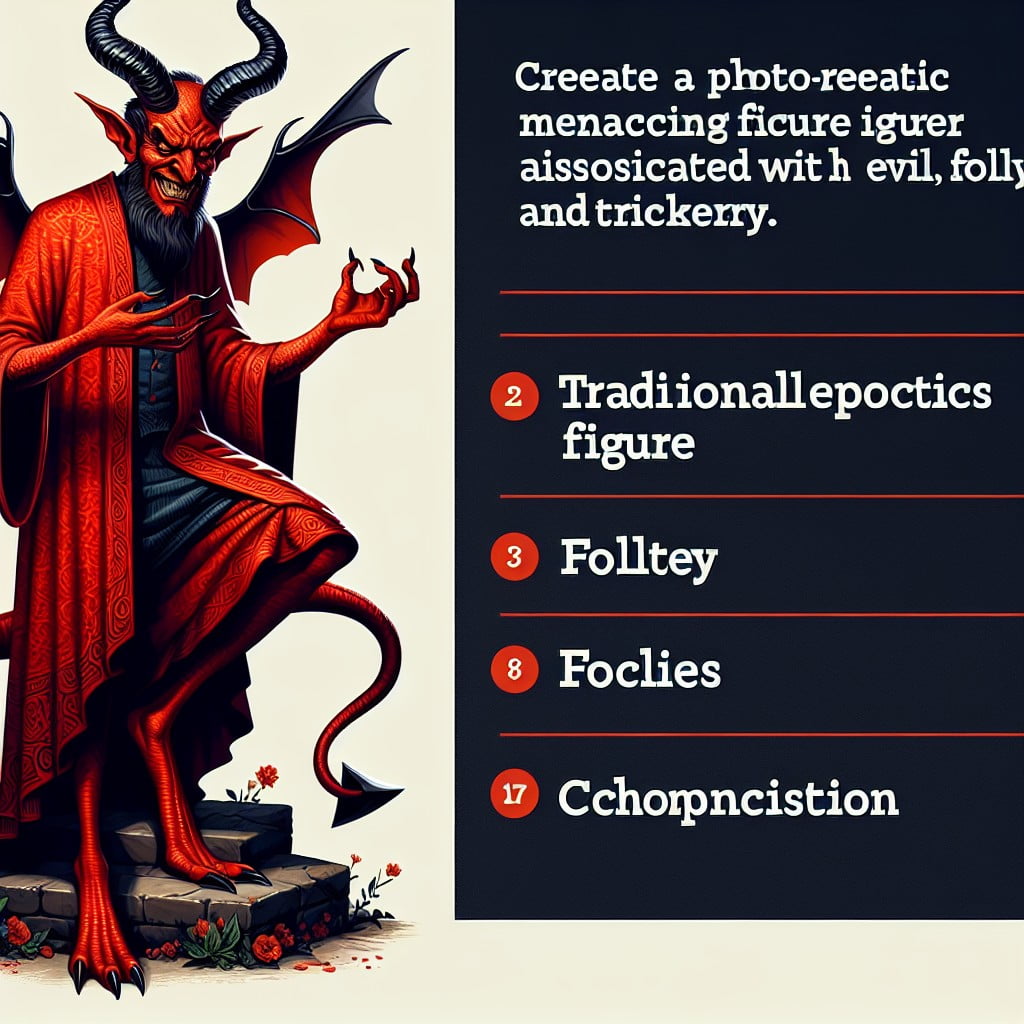Exploring the comparative analysis of Jesus versus the Devil becomes enlightening because it unwraps the profound differences between concepts of good and evil in Christian theology.
Key takeaways:
- Origin: The devil is a fallen angel challenging God’s authority.
- Symbolism: The devil represents evil and temptation.
- Intentions: The devil aims to undermine virtue and sever the connection to the divine.
- Duality: The devil reflects the ongoing battle between good and evil.
- Depictions in Scripture: Scripture details the devil’s deception and misguidance.
Understanding the Devil

In examining the nature of the devil, several key concepts emerge:
1. Origin: The devil, also known as Satan or Lucifer in different traditions, is often depicted as a fallen angel, traditionally challenging God’s authority and seeking to lead humanity astray.
2. Symbolism: Beyond a personal entity, the devil represents the embodiment of evil and temptation. In many faiths, this figure symbolizes the internal and external forces that encourage individuals to act against their moral compass and spiritual well-being.
3. Intentions: The devil’s agenda is depicted as one that aims to undermine human virtue and to sever the connection between individuals and the divine. It feeds on weaknesses, leveraging pride, doubt, and desire to persuade and misguide.
4. Duality: The concept of the devil is central to the dualistic nature of good versus evil, often illustrating the ongoing spiritual battle for the human soul. This duality reflects a balance where the presence of good necessitates the existence of its contrary.
5. Depictions in Scripture: Scriptural texts describe the devil’s interactions with humanity, detailing various encounters where the primary goal is to lead people away from truth and righteousness through cunning and deception.
Understanding these facets aids in grasping the role of the devil in the broader context of spiritual narratives and moral philosophies.
Jesus Vs. Devil – The Showdown in the Wilderness

In the wilderness, the narrative unfolds as a dramatic encounter that exemplifies the struggle between good and evil. Jesus fasted for 40 days and nights, emphasizing the importance of spiritual preparation and resilience.
When the devil tempts Jesus, it’s a testament to the strength of character and moral fortitude. The devil’s three temptations target physical needs, power, and pride, yet Jesus counters each with scripture, showing that spiritual sustenance triumphs over worldly desires.
This episode is not only illustrative of Jesus’ divinity and mission but also serves as a blueprint for handling temptation:
- The use of fasting to reinforce spiritual resolve.
- Jesus’ reliance on scripture as a defense.
- The significance of humility and trust in divine providence over materialism and earthly power.
This confrontation illuminates the path for personal spiritual growth and the means to withstand challenges to one’s faith.
The First Temptation
After a 40-day fast in the wilderness, during a moment of physical weakness and vulnerability, Jesus encountered his first test. In this instance, the devil challenged him to turn stones into bread, leveraging hunger to sway Jesus from his divine mission. Here’s what stands behind this temptation:
- Hunger as metaphoric vulnerability: The urge represents our most basic needs and temptations that arise in our weakest states.
- Miracles for personal gain: The devil prompts misuse of divine power, hinting at ethical use of abilities.
- Man does not live by bread alone: Jesus’ response emphasizes spiritual nourishment over physical satisfaction, pointing to a hierarchy of needs where the spiritual transcends the material.
- Dependence on God: It’s a lesson in relying not on one’s own abilities to quench immediate desires but on God’s word and timing.
These points highlight the nature of temptation as a universal experience and the importance of steadfastness and integrity in the face of personal desires.
The Second Temptation
In the narrative of the second temptation, the devil transports Jesus to the pinnacle of the Temple in Jerusalem, challenging Him to throw Himself down. The devil quotes Scripture, misusing Psalm 91:11-12 to suggest that God’s angels would protect Jesus from harm. This temptation targets the trust and relationship between Jesus and the Father, as well as addressing human desires for dramatic signs of divine intervention and protection.
Key points to understand regarding this temptation include:
- Temptation of the spectacular: The devil seeks to coax Jesus into demanding a miraculous show of God’s power, effectively testing God’s faithfulness.
- Misuse of scripture: The devil’s quotation of the Psalm reveals a twisted interpretation meant to deceive, highlighting the importance of context and intention when understanding Biblical teachings.
- Trust and faith: The underlying challenge is whether Jesus would manipulate the Father’s promises for His own ends, questioning the integrity of God’s word and plan.
- Jesus’ response: Jesus counters the temptation with another scripture, Deuteronomy 6:16, reasserting the principle that testing God’s providence and faithfulness is not the path of righteousness.
This moment exemplifies the importance of discernment, humility, and the proper appropriation of faith that does not seek to control or test divine power for personal ends.
The Third Temptation
In the Gospel of Matthew, the third temptation presents the most direct challenge to Jesus’s mission. The devil takes Jesus to a high mountain, from where all the kingdoms of the world and their splendor are visible, offering them in exchange for Jesus’s worship.
The offering of worldly power: This temptation targets the human desire for control and sovereignty over earthly realms.
The test of priorities: It probes at the choice between temporary, material power and eternal, spiritual values.
Worship as the central issue: The devil demands worship, an act due only to God, pushing the boundary between reverence and blasphemy.
Jesus’s response: With the scripture “Worship the Lord your God, and serve him only,” Jesus affirms the fundamental command to hold God as paramount above all, rejecting any form of idolatry.
By refuting this final temptation, Jesus demonstrates total allegiance to God and rejects the illusion of worldly dominion as a substitute for true spiritual authority. This act reinforces the principle that spiritual integrity is not to be traded for temporal power.
Overcoming Temptation and Defeating the Devil
Addressing temptations requires a blend of self-awareness and spiritual resilience. Here’s how to navigate these challenges:
Identify Your Vulnerabilities: Acknowledge personal weaknesses to reinforce your defenses against temptations that exploit them.
Embrace the Power of ‘No’: Build the habit of declining immediate gratification in favor of long-term spiritual health.
Seek Wisdom in Scripture: Biblical teachings can offer guidance and strength, providing a roadmap for resisting temptation.
Stay Connected in Community: Surround yourself with a supportive network that encourages positive choices and accountability.
Cultivate Spiritual Disciplines: Practices like prayer, meditation, and mindfulness can sharpen your spiritual acuity, making it easier to discern and resist unhealthy urges.
Remember Your Identity: Recognize that your worth is not determined by succumbing to or resisting temptation but by your intrinsic value.
By integrating these strategies into daily life, the grip of temptation loosens, allowing for a more mindful and centered approach to challenges, akin to the ways depicted in Jesus’ encounters with the devil.
The Final Victory – Jesus Vs. Devil
The culmination of the conflict between good and evil is powerfully symbolized in the death and resurrection of Jesus Christ. This event signifies the ultimate triumph over the forces of darkness:
- Defeat of Sin: By willingly enduring the crucifix, Jesus took upon Himself the sins of humanity, offering a path to redemption.
- Resurrection as Victory: Jesus’ resurrection is the cornerstone of Christian faith, representing His victory over death and the devil’s ultimate defeat.
- Empowerment of Believers: This victory is not just cosmic; it echoes in the personal spiritual lives of believers, enabling them to overcome their own daily struggles with temptation and evil.
- Hope for Eternity: The final victory assures Christians of eternal life, with Jesus’ resurrection as the guarantee of their own resurrection to come.
These points encapsulate the essence of Jesus’ final triumph, offering a framework for understanding the deep significance of this event for individuals and the broader spiritual narrative.
Understanding Spiritual Warfare
Spiritual warfare is the ongoing battle between the forces of good and evil. Here are some key points to understanding this concept:
- It’s a battle in the spiritual realm that influences the physical world.
- Individuals experience it as a conflict between the desires of the spirit and the temptations of the flesh.
- Prayer, meditation, and the study of religious texts are tools used to strengthen one’s spirit against such influences.
- Mindfulness in one’s thoughts and actions is crucial for discernment between right and wrong.
- The support of a community with shared beliefs can provide added strength and guidance.
By recognizing the nuances of spiritual warfare, individuals can be better prepared to navigate moral challenges and personal growth.
The Role of Angels in the Battle
Angels, as depicted in various religious texts, serve as divine messengers and warriors, playing a pivotal role in the cosmic struggle between good and evil. Here’s a brief exploration of their functions:
- Divine messengers: Angels communicate God’s will and provide guidance to aid in spiritual battles.
- Protectors: They are often described as guardians who defend humans from demonic influences.
- Warriors of light: In the struggle between Jesus and the devil, angels are perceived as fighting alongside the forces of good.
- Intercessors: They can intercede on behalf of humanity, seeking divine assistance in resisting temptation and evil.
- Instruments of God’s judgment: At times, they enact divine justice, maintaining the balance between the righteous path and evil actions.
Angels’ presence in the narrative serves to remind believers of the unseen support available to them in their own struggles against temptation and moral adversity.
What the Satan Vs Jesus Battle Means to Us
The clash between Jesus and Satan holds deep spiritual significance, reflecting an eternal struggle between good and evil that continues to resonate in our lives. Here are some of the key takeaways:
- Personal Empowerment: The narrative reminds us that, like Jesus, we have the strength to resist temptation and pursue a path of righteousness despite the challenges we may face.
- Moral Compass: In depicting Jesus as the embodiment of virtue, the story serves as a moral guide, encouraging individuals to reflect upon their choices and actions.
- Spiritual Resilience: The battle exemplifies the importance of faith and determination in overcoming obstacles, suggesting that spiritual resilience can lead to triumph over negative forces.
- Purpose and Hope: The eventual triumph of Jesus offers assurance that despite the presence of evil in the world, there is a greater purpose and hope for redemption and peace.
- Role of Community: Recognizing that the struggle against negative influences is not carried out in isolation, the account underscores the value of supportive relationships and collective moral courage.
Understanding these concepts fosters a deeper appreciation for the ongoing relevance of this ancient confrontation in the context of modern spiritual and ethical life.